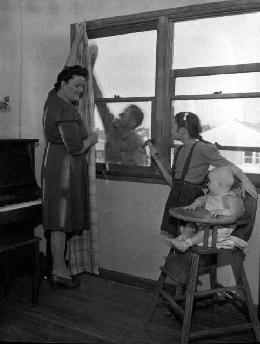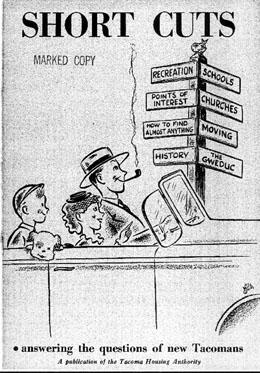This is a slideshow on the history of Tacoma's Salishan Housing Project, built during World War II to house shipyard workers and military families. This slide show tour was written and curated by David Wilma. Presented by the Tacoma Housing Authority.
Tacoma's Salishan Housing Project -- A Slideshow
- By David Wilma
- Posted 8/29/2005
- HistoryLink.org Essay 7455

When the United States entered World War II, Tacoma became a center for military training and shipbuilding. Thousands of military personnel and workers crowded into Tacoma and created a housing crunch. The Tacoma Housing Authority, with federal monies, started construction on Salishan, a 2,000-unit housing project close to the shipyards on Commencement Bay.
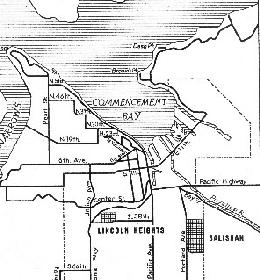
Salishan was one of several housing projects built during the war years. Lincoln Heights and American Lake Gardens were close to Fort Lewis and McChord Field. The Tacoma Housing Authority chose a site on Portland Avenue at 40th Street that was close to the shipyards on Commencement Bay and that already had sewer and power lines near by.

Construction started on 2,000 units in the summer of 1942. Lumber for the homes was cut from trees found on the 465-acre site.
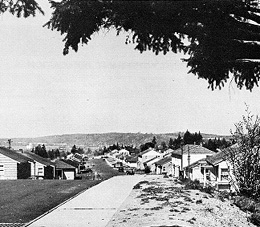
Salishan’s planners wanted to create a sense of community and a reason for people to make the project their homes after the war ended. The curvilinear streets took advantage of the natural contours of the land. Buildings were set apart without fences and a mix of designs provided some variety to the usual sameness of public housing projects.
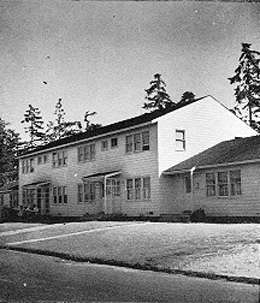
The project consisted of a mix of single-family units, duplexes, triplexes, and sixplexes like the one at right. The designers worked to provide variety in the neighborhood.

Since copper wire was a strategic material, new individual telephones were prohibited and residents were served by neighborhood phone booths. People lined up rain or shine, day or night to make calls. One resident dramatized the need for phone service by showing off with semaphore flags.

Coal provided heat for warmth, hot water, and cooking. Here, residents were instructed how to operate their appliances.

In the 1940s, the residents organized to communicate their interests with project managers and to form a sense of community. One early program was a home beautiful contest in which residents competed for cash prizes by landscaping their yards.
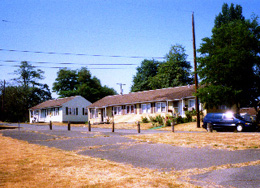
In 1943, Salishan was little more than graded streets and buildings. Landscaping and sidewalks came later. Sixty years later, the trees had grown up, but the design of the community and the homes still had the original feel.
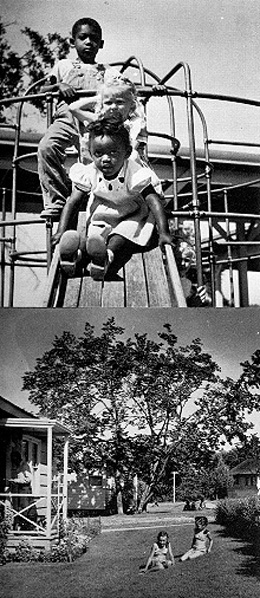
After the war was won in 1945, the shortage of housing continued. Veterans returned home to build families and by 1950, half the residents were children.
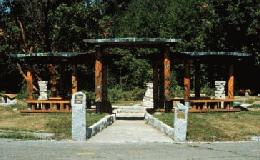
By 1991, residents and the Tacoma Housing Authority organized to fight crime and the declining sense of community at Salishan. In 1997, a new Gathering Place was created adjacent to the community garden.

The community garden opened as a place for neighbors to raise their own fresh produce and to meet one another. The diversity of cultures at Salishan was represented in the foods grown here.

In 1996, Washington State University opened the Salishan Learning Center to provide residents the opportunity to learn new skills and to earn college credits. Many Salishan residents were immigrants and the program eased their entry into the new country.
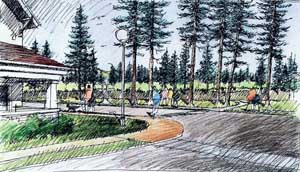
In 2000, Tacoma Housing Authority was awarded a federal grant to revitalize Salishan and to replace the existing units with new rental and homeownership units.
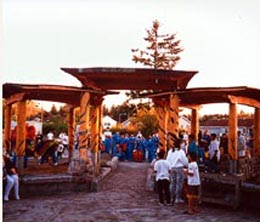
Salishan residents speak 23 different languages and the Gathering Place offers opportunities for diverse groups to gather and share their cultures. The Gathering Place was designed by Milenko Matanovic and was constructed with copper from the roof of the old Union Depot and with cobblestones from historic Tacoma streets.
Licensing: This essay is licensed under a Creative Commons license that encourages reproduction with attribution. Credit should be given to both HistoryLink.org and to the author, and sources must be included with any reproduction. Click the icon for more info. Please note that this Creative Commons license applies to text only, and not to images. For more information regarding individual photos or images, please contact the source noted in the image credit.


